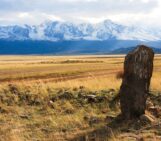
Mother Tree, Mongolia . Credit: Gantuya Ganbat (distributed via imaggeo.egu.eu)
Landlocked, home to mountains, deserts and the southernmost permafrost territories, Mongolia’s climate is harsh. Warm, often humid summers, give way to freezing winters where temperatures dip as low as -25°C. Rainfall is restricted to a short period in the summer months of June and August.
These climatic factors, combined with the lack of a strong forest management strategy and anthropogenic influences, mean that only 11% of the vast 1567 million km² of the Mongolian territory (that is larger than the area covered by Germany, Italy, France and the UK combined), is covered by forests.
The majority of forests are located in the northern part of the country, along the border with Russia. They form a transition zone between the cold, subarctic forests of Siberia and the vast steppes of southern Asia.
This week’s Imaggeo on Mondays image is the imposing, and holy, Mother Tree. Located in one of the many Tujiin Nars (pine forests) of the northern Selenge Aimag province, this giant pine is worshiped by locals who believe if you ask a wish of the Mother Tree, it will come true. Its lowermost branches are lavishly decorated with Khadags, traditional Tibetan Buddhist ceremonial scarves, brought as offerings by locals and foreign visitors alike.
Imaggeo is the EGU’s online open access geosciences image repository. All geoscientists (and others) can submit their photographs and videos to this repository and, since it is open access, these images can be used for free by scientists for their presentations or publications, by educators and the general public, and some images can even be used freely for commercial purposes. Photographers also retain full rights of use, as Imaggeo images are licensed and distributed by the EGU under a Creative Commons licence. Submit your photos at http://imaggeo.egu.eu/upload/.



